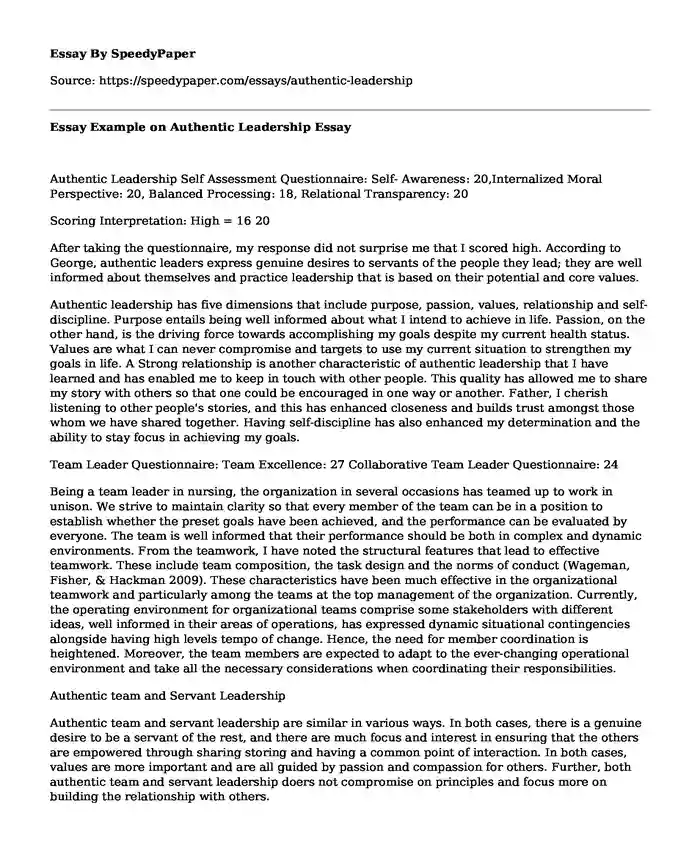
| Type of paper: | Essay |
| Categories: | Leadership analysis Management Personality |
| Pages: | 3 |
| Wordcount: | 604 words |
Authentic Leadership Self Assessment Questionnaire: Self- Awareness: 20,Internalized Moral Perspective: 20, Balanced Processing: 18, Relational Transparency: 20
Scoring Interpretation: High = 16 20
After taking the questionnaire, my response did not surprise me that I scored high. According to George, authentic leaders express genuine desires to servants of the people they lead; they are well informed about themselves and practice leadership that is based on their potential and core values.
Authentic leadership has five dimensions that include purpose, passion, values, relationship and self-discipline. Purpose entails being well informed about what I intend to achieve in life. Passion, on the other hand, is the driving force towards accomplishing my goals despite my current health status. Values are what I can never compromise and targets to use my current situation to strengthen my goals in life. A Strong relationship is another characteristic of authentic leadership that I have learned and has enabled me to keep in touch with other people. This quality has allowed me to share my story with others so that one could be encouraged in one way or another. Father, I cherish listening to other people's stories, and this has enhanced closeness and builds trust amongst those whom we have shared together. Having self-discipline has also enhanced my determination and the ability to stay focus in achieving my goals.
Team Leader Questionnaire: Team Excellence: 27 Collaborative Team Leader Questionnaire: 24
Being a team leader in nursing, the organization in several occasions has teamed up to work in unison. We strive to maintain clarity so that every member of the team can be in a position to establish whether the preset goals have been achieved, and the performance can be evaluated by everyone. The team is well informed that their performance should be both in complex and dynamic environments. From the teamwork, I have noted the structural features that lead to effective teamwork. These include team composition, the task design and the norms of conduct (Wageman, Fisher, & Hackman 2009). These characteristics have been much effective in the organizational teamwork and particularly among the teams at the top management of the organization. Currently, the operating environment for organizational teams comprise some stakeholders with different ideas, well informed in their areas of operations, has expressed dynamic situational contingencies alongside having high levels tempo of change. Hence, the need for member coordination is heightened. Moreover, the team members are expected to adapt to the ever-changing operational environment and take all the necessary considerations when coordinating their responsibilities.
Authentic team and Servant Leadership
Authentic team and servant leadership are similar in various ways. In both cases, there is a genuine desire to be a servant of the rest, and there are much focus and interest in ensuring that the others are empowered through sharing storing and having a common point of interaction. In both cases, values are more important and are all guided by passion and compassion for others. Further, both authentic team and servant leadership doers not compromise on principles and focus more on building the relationship with others.
Conclusion
To conclude, authentic team and servant leadership are very significant tools in an organization that all focus on ensuring that the organization succeeds. The diversification brought about through teamwork enhances chances for enhancing innovations based on the different ideas. Authentic leaders have higher chances of succeeding in operations and adjust to the ever-changing environment.
References
Northouse, P. G. (2016). Leadership: Theory and practice (7th ed.). Thousand Oaks: CA: SagePublications.
Zaccaro, S. J., &Klimoski, R. (2001). The nature of organizational leadership. In: S. J. Zaccaro, & R. Klimoski (Eds.),The nature of organizational leadership: understanding the performance imperatives confronting todays leaders ( pp. 341). San Francisco: Jossey-Bass.
Cite this page
Essay Example on Authentic Leadership. (2019, Nov 05). Retrieved from https://speedypaper.net/essays/authentic-leadership
Request Removal
If you are the original author of this essay and no longer wish to have it published on the SpeedyPaper website, please click below to request its removal:
- Admission Essay Sample for a CRNA Program in TCU
- Differences in Health Traditions Between Different Cultures, Essay Example
- Essay Sample for You: The Basis for Ethical Conduct
- Firm Analysis on Tenet Healthcare Corporation, Free Essay
- Case Study: HIPAA, CIA, and Safeguards, Free Essay for Everyone
- Essay Sample on Gender Roles in Dracula
- Embracing Humanity: A Lesson Learned from Unexpected Friendship - Report Sample
Popular categories




